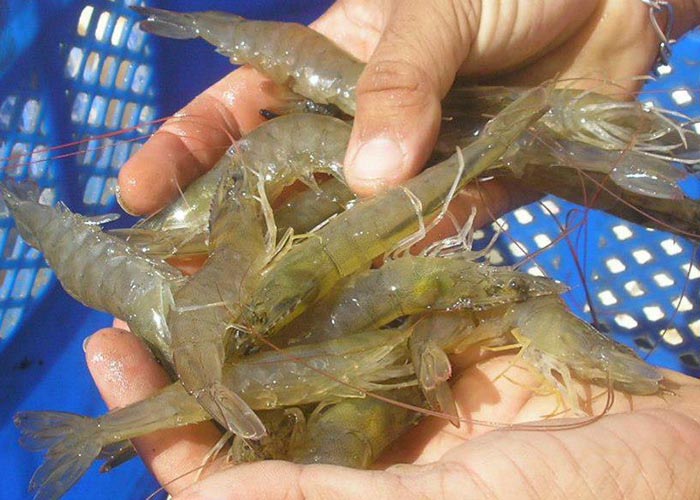International aquacultural project offers first results
International aquacultural project offers first results
Photo: Laurindo Rodrigues

AquaVitae has researched shrimp and other sea and freshwater aquacultural species
Embrapa and other Brazilian research centers are participating in the consortium
Over 100 new prototypes for aquaculture value chains were presented last week, when researchers and aquaculture producers, from all over the Atlantic, met online to share results from the first year of the AquaVitae project, which is funded by the European Union. The prototypes are the first outputs from the collaboration between aquaculture companies and researchers in the project. Embrapa is participating in the consortium through four of its research centers: Embrapa Fisheries and Aquaculture (Palmas, TO), Embrapa Coastal Tablelands (Aracaju, SE), Embrapa Mid-North (Teresina, PI) and Embrapa Western Amazon (Manaus, AM). The corporation has researched two freshwater fish species (tambaqui and pirarucu), oysters and integrated multi-trophic cultivation, on top of cross-cutting themes like policy and governance, economics and marketing, sensors, and data management.
For Eric Arthur Bastos Routledge, head of Research and Development at Embrapa Fishery and Aquaculture, the balance of the first year of the project was very positive, especially with the establishment of partnerships. “We have created a very positive partnership with Unesp's Jaboticabal campus and with Nofima (the Norwegian Institute of Food, Fisheries and Aquaculture Research), which coordinates the project. Not to mention the closer ties with other Embrapa centers and the opportunities for relationships with the other institutions that are part of the consortium, even if we do not have directly related shared activities. All of that facilitates the establishment of partnerships for future projects”, he remarks.
Philip James, project coordinator and senior scientist at Nofima, agrees. “I believe that AquaVitae had a satisfactory first year. Innovative solutions will be further developed throughout the life of the project. But this is an excellent starting point,” he says.
Eight million euros for aquaculture
AquaVitae is the largest scientific consortium ever established, to study aquaculture in the Atlantic and within the continents bathed by the ocean. Estimated at eight million euros, mostly from the European Union program Horizon 2020, da União Europeia, the project gathers 35 partners from the fish industry and research institutions from 15 different countries spread in four continents. In Brazil, besides Embrapa, the other participating education institutions with expertise in aquacultural research are the Federal University of Santa Catarina (UFSC), the Federal University of Rio Grande (FURG) and São Paulo State University (Unesp), in addition to the organic aquaculture company Primar Aquacultura.
The main goal of the project is to increase aquacultural production through research to be developed in the next four years. “This will be achieved especially through the development of new species of a low trophic level (in the food chain), which are at the base of the energy pyramid, such as seaweed and mollusks, for example”, explains the researcher from Embrapa Fishery and Aquaculture Lucas Torati, one of Aquavitae's coordinators in Brazil. With this, the scientists intend to work in systems in which waste at each trophic level are reduced using residue from the other.
“For instance, if we put in the same production system a carnivorous fish with another filter feeder, leftover feed the carnivore leaves behind will become a nutrient for the seaweed, which in turn will be consumed by the filtering fish. A different production system one can call multitrophic”, Torati illustrates.
An All-Atlantic virtual meeting
The annual meeting was originally supposed to be held in Flórianopolis, Brazil. But due to the Covid-19 pandemic, the 80 participants met virtually instead. The meeting lasted three days and included a workshop with Brazilian stakeholders, in support of increased research collaboration between Europe and Brazil.
Other participants include the Brazilian Fish Farming Association (PeixeBR), the Brazilian Shrimp Farmers Association (ABCC), the Ministry of Agriculture's Secretariat of Aquaculte and Fishery (SAP/MAPA), the Ministry of Science,Technology, Innovations and Communications (MCTIC), the Brazil's Confederation of Agriculture and Livestock(CNA), the Federation of Industries of São Paulo State (FIESP) and aquacultural farmers. The meeting also had representatives from the aquacultural sector in South Africa.
In the project, Embrapa Fisheries and Aquaculture has partnered with the agribusinesses Piscicultura Raça (Canabrava do Norte, MT); São Paulo Farm (Brejinho de Nazaré, TO); Água Limpa Farm (Aliança do Tocantins-TO) and Hidrobios (Palmas-TO).
Translation: Mariana Medeiros, based on Aquavitae news article.
Elisângela Santos (19.500 MTb-RJ)
Embrapa Fisheries and Aquaculture
Press inquiries
pesca-e-aquicultura.imprensa@embrapa.br
Phone number: +55 63 99953 5432
Further information on the topic
Citizen Attention Service (SAC)
www.embrapa.br/contact-us/sac/
